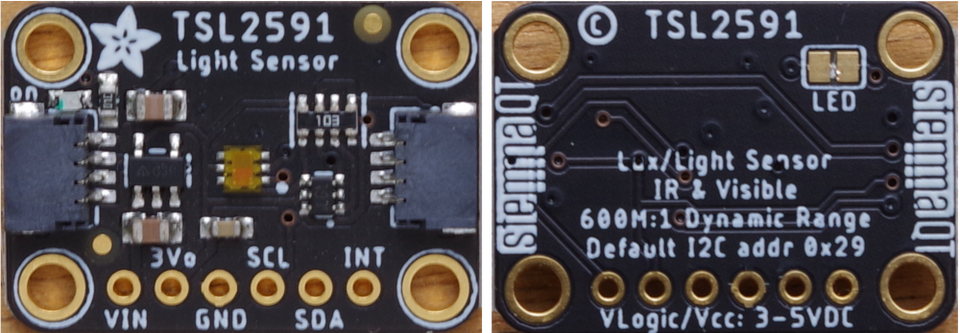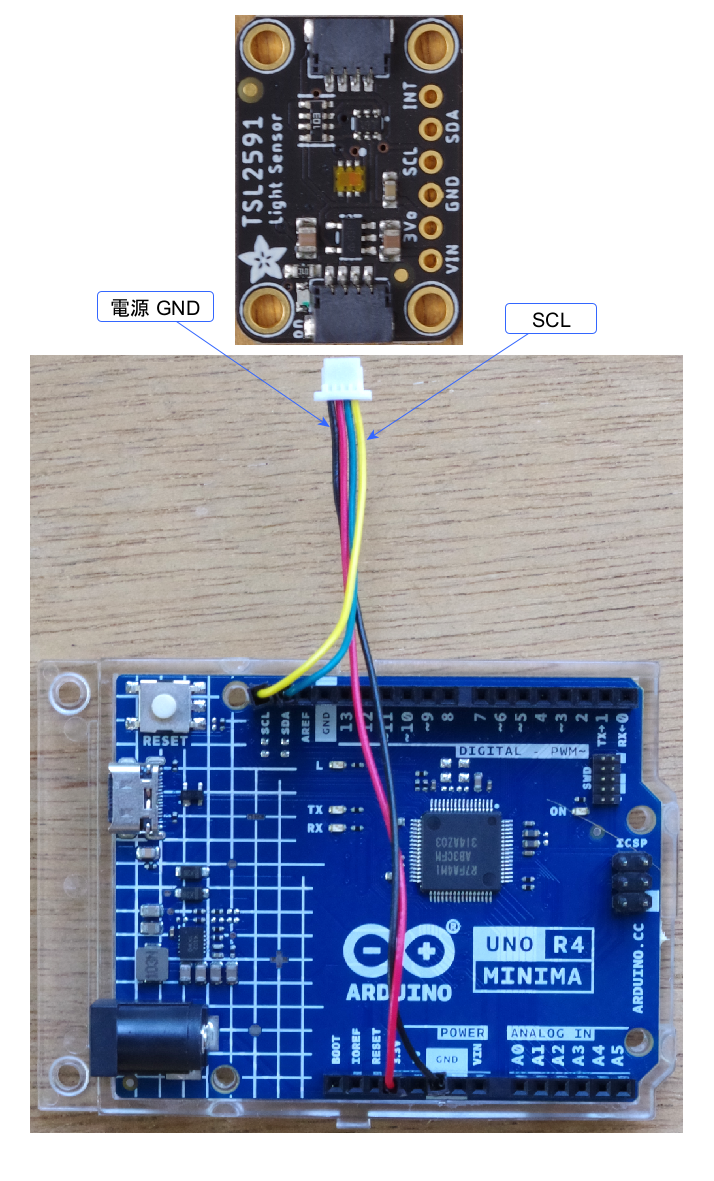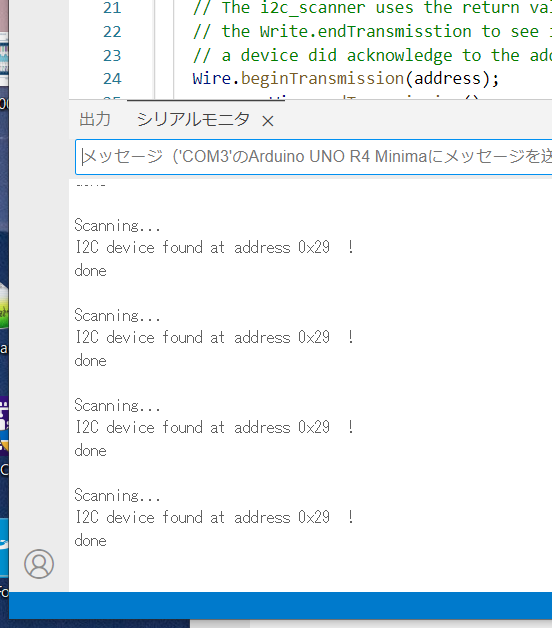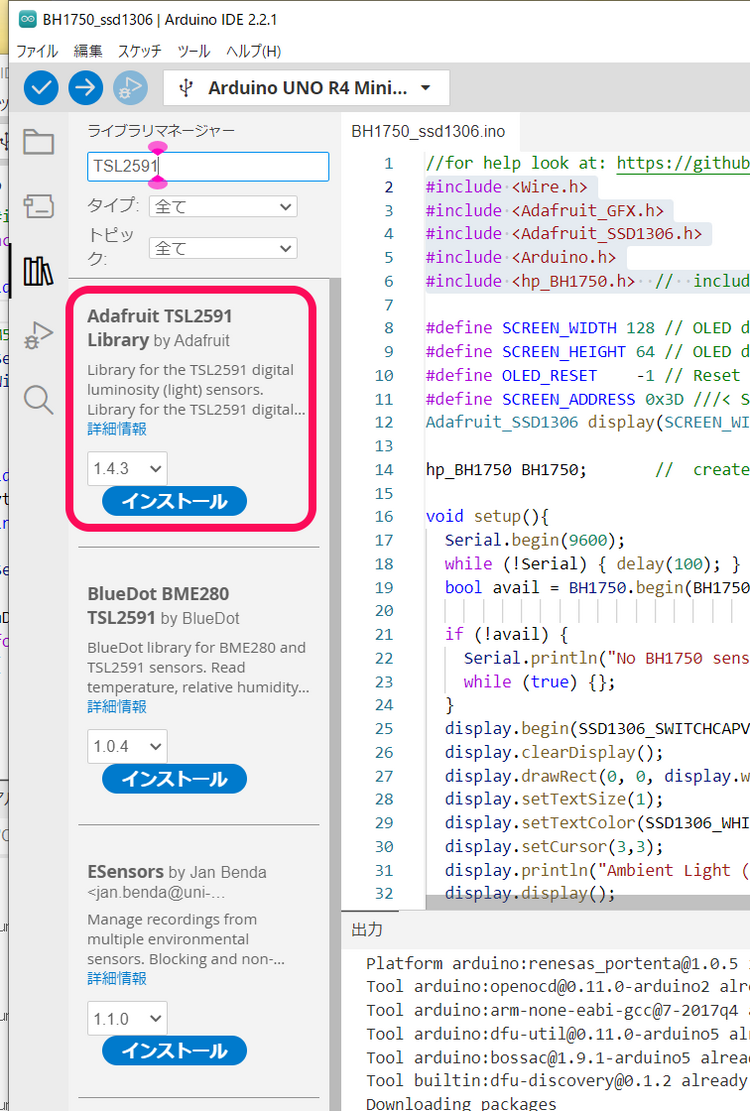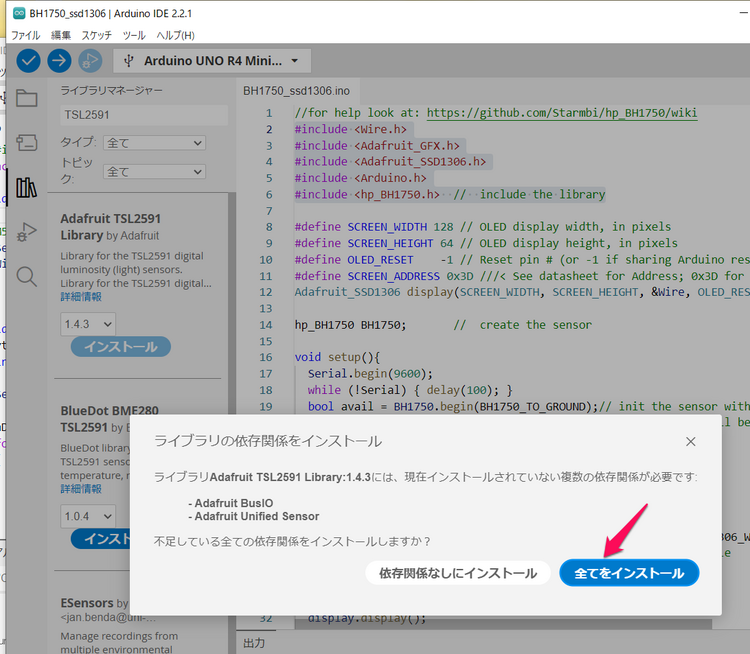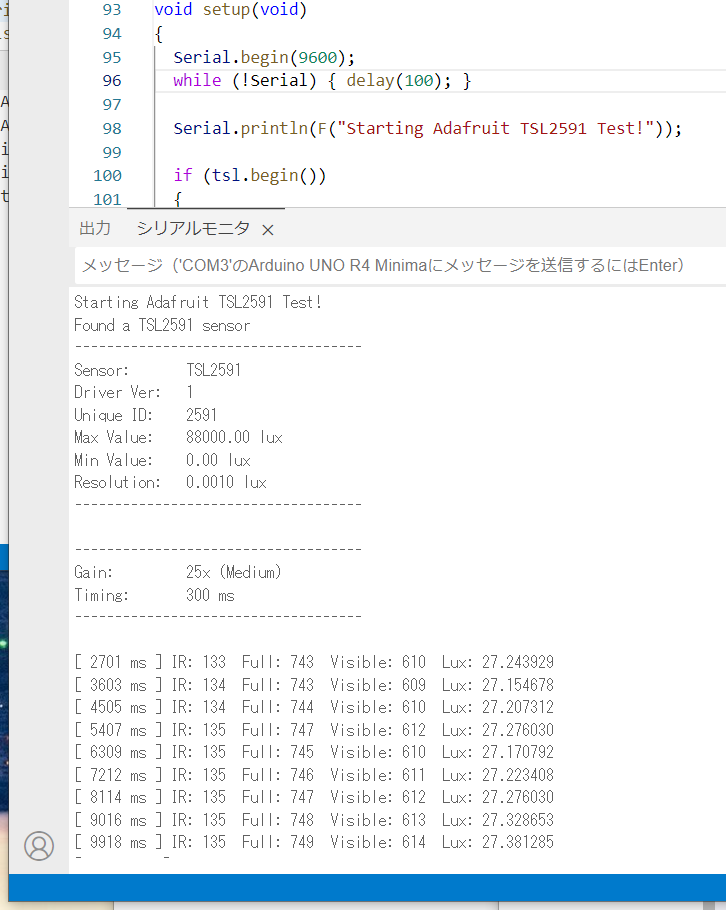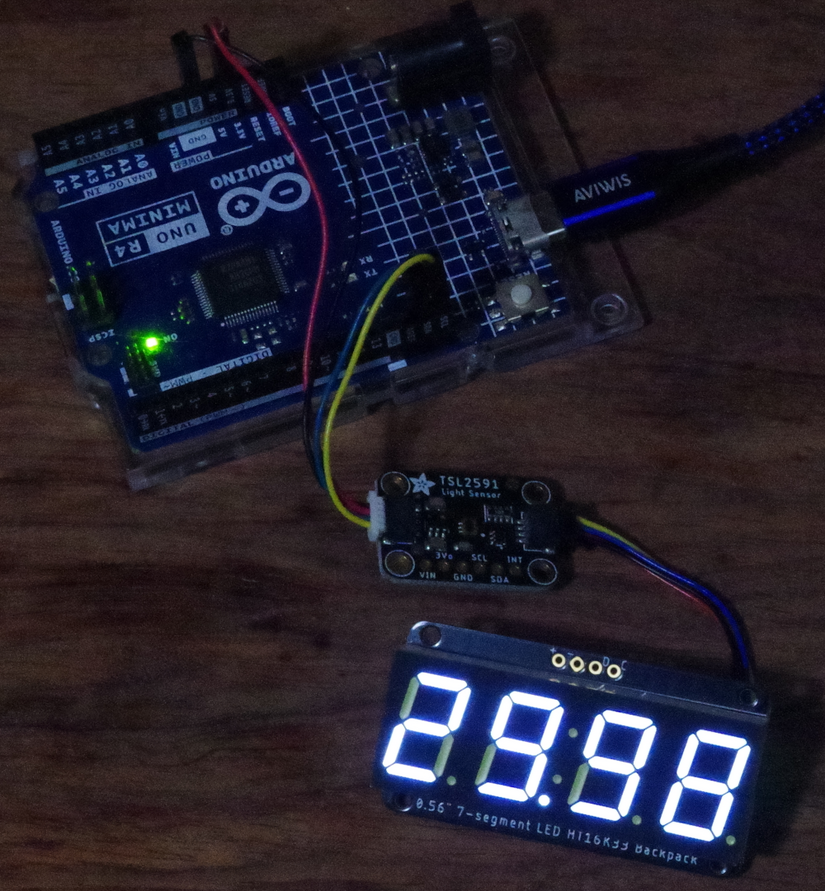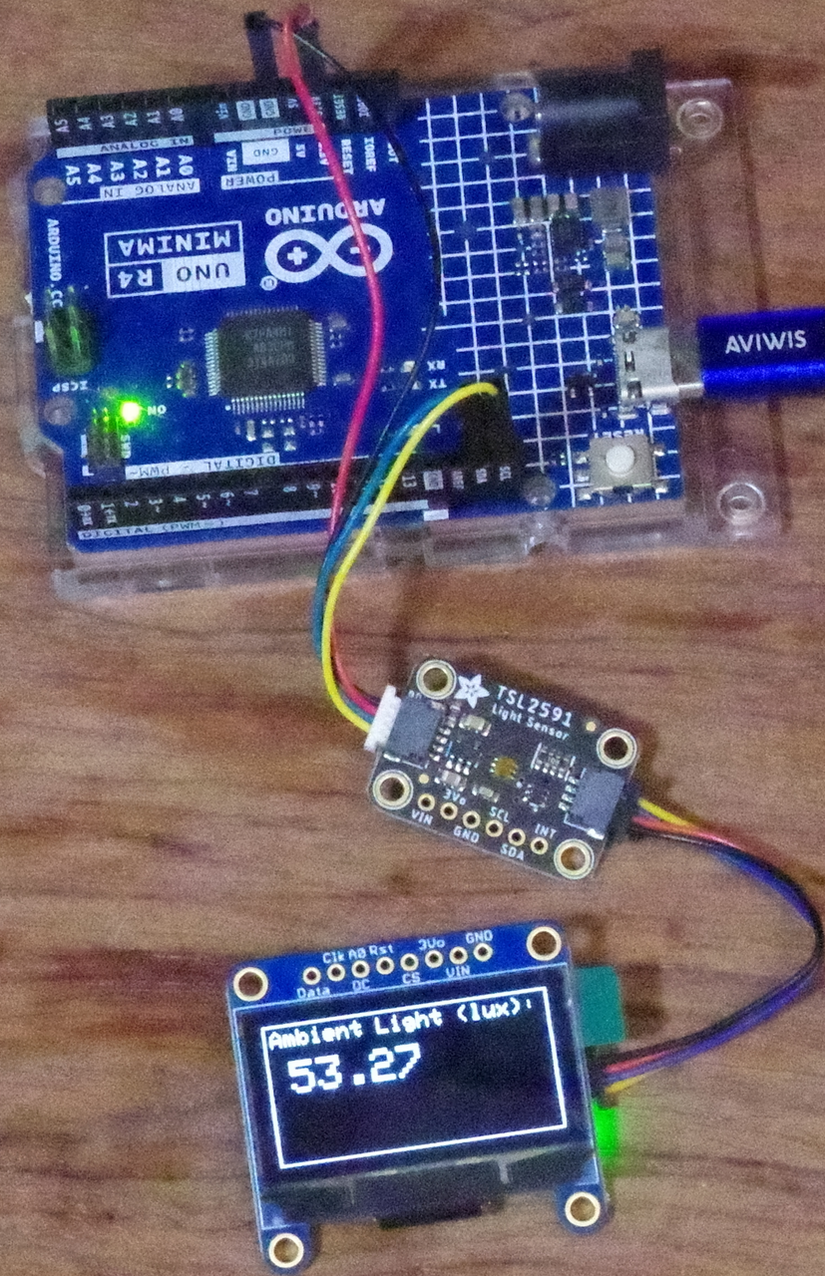Arduino UNO R4 Minimaでセンサ・インターフェーシング ㉙ 光センサ TSL2591
Adafruitから周辺光センサ TSL2591(ams)を利用します。
●AdafruitのStemma QT/Qwiicボード
Stemma QT/Qwiic(JST SH 4ピン)コネクタは2か所に装着されていて、どちらにつないでもかまいません。このコネクタを使ってI2Cで制御する場合、特に、ジャンパ線をつなぐなどは不要です。
コネクタは、表と裏のどちらも差し込めそうですが、ピンが内部の上部に並んでいるので、差し込める方向は一意です。ロック機構はないですが、すぐに抜けるということはありません。
●光センサTSL2591のおもなスペック
- 動作電圧 2.7~3.6V
- 動作温度範囲 -30~70°C
- 測定可能範囲 188μ~88000Lux
- ダイナミック・レンジ 600000000:1
- インターフェース I2C(0~400kHz)
- スレーブ・アドレス 0x29
●使用環境
- Arduino UNO R4 Minima
- Arduino IDE 2.2.1
- Windows10 22H2
●接続
Arduino UNO R4 MinimaのI2C信号とセンサ・ボードをJSTコネクタでつなぎます(Stemma QT/Qwiicボードの写真の比率は異なる)。
●スレーブ・アドレスを確認
従来からよく使われているi2cScanner.inoを動かしてスレーブ・アドレスを確認します。電源は3.3Vです。
0x29を見つけてきました。
●ライブラリの用意
TSL2591で検索して、見つかった Adafruit TSL2591ライブラリをインストールします。
インストールを始めたとき、関連のライブラリや依存関係をインストールするかというパネルが出た場合は、全てをインストールを選びます。
●サンプル・スケッチ
メニューのファイル->スケッチ例から、Adafruit TSL2591 Libraryのtsl2591.inoを選択します。
setup{}の最初の部分に1行追加します。
void setup(void)
{
Serial.begin(9600);
while (!Serial) { delay(100); }
コンパイル、実行します。
●4桁の7セグメントLED表示器をつないで測定結果を表示する
連載の第4回目の記事を参照しながら表示器を接続します。
Arduino UNO R4 Minimaでセンサ・インターフェーシング ④ 温湿度センサSi7021の測定結果を7セグメントLEDに表示
スケッチです。
7セグメントLED表示器は、第12回 温湿度センサ SHTC3でスレーブ・アドレスが重なったので、デフォルトの0x70から、ジャンパのA0をショートして0x71に変更してあります。デフォルトのまま使うときは0x70で使ってください。
#include <Wire.h>
#include <Adafruit_GFX.h>
#include "Adafruit_LEDBackpack.h"
#include <Adafruit_Sensor.h>
#include "Adafruit_TSL2591.h"
Adafruit_7segment matrix = Adafruit_7segment();
Adafruit_TSL2591 tsl = Adafruit_TSL2591(2591); // pass in a number for the sensor identifier (for your use later)
/**************************************************************************/
/*
Displays some basic information on this sensor from the unified
sensor API sensor_t type (see Adafruit_Sensor for more information)
*/
/**************************************************************************/
void displaySensorDetails(void)
{
sensor_t sensor;
tsl.getSensor(&sensor);
Serial.println(F("------------------------------------"));
Serial.print (F("Sensor: ")); Serial.println(sensor.name);
Serial.print (F("Driver Ver: ")); Serial.println(sensor.version);
Serial.print (F("Unique ID: ")); Serial.println(sensor.sensor_id);
Serial.print (F("Max Value: ")); Serial.print(sensor.max_value); Serial.println(F(" lux"));
Serial.print (F("Min Value: ")); Serial.print(sensor.min_value); Serial.println(F(" lux"));
Serial.print (F("Resolution: ")); Serial.print(sensor.resolution, 4); Serial.println(F(" lux"));
Serial.println(F("------------------------------------"));
Serial.println(F(""));
delay(500);
}
/**************************************************************************/
/*
Configures the gain and integration time for the TSL2591
*/
/**************************************************************************/
void configureSensor(void)
{
// You can change the gain on the fly, to adapt to brighter/dimmer light situations
//tsl.setGain(TSL2591_GAIN_LOW); // 1x gain (bright light)
tsl.setGain(TSL2591_GAIN_MED); // 25x gain
//tsl.setGain(TSL2591_GAIN_HIGH); // 428x gain
// Changing the integration time gives you a longer time over which to sense light
// longer timelines are slower, but are good in very low light situtations!
//tsl.setTiming(TSL2591_INTEGRATIONTIME_100MS); // shortest integration time (bright light)
// tsl.setTiming(TSL2591_INTEGRATIONTIME_200MS);
tsl.setTiming(TSL2591_INTEGRATIONTIME_300MS);
// tsl.setTiming(TSL2591_INTEGRATIONTIME_400MS);
// tsl.setTiming(TSL2591_INTEGRATIONTIME_500MS);
// tsl.setTiming(TSL2591_INTEGRATIONTIME_600MS); // longest integration time (dim light)
/* Display the gain and integration time for reference sake */
Serial.println(F("------------------------------------"));
Serial.print (F("Gain: "));
tsl2591Gain_t gain = tsl.getGain();
switch(gain)
{
case TSL2591_GAIN_LOW:
Serial.println(F("1x (Low)"));
break;
case TSL2591_GAIN_MED:
Serial.println(F("25x (Medium)"));
break;
case TSL2591_GAIN_HIGH:
Serial.println(F("428x (High)"));
break;
case TSL2591_GAIN_MAX:
Serial.println(F("9876x (Max)"));
break;
}
Serial.print (F("Timing: "));
Serial.print((tsl.getTiming() + 1) * 100, DEC);
Serial.println(F(" ms"));
Serial.println(F("------------------------------------"));
Serial.println(F(""));
}
/**************************************************************************/
/*
Program entry point for the Arduino sketch
*/
/**************************************************************************/
void setup(void)
{
Serial.begin(9600);
while (!Serial) { delay(100); }
Serial.println(F("Starting Adafruit TSL2591 + 7segmentLED"));
if (tsl.begin())
{
Serial.println(F("Found a TSL2591 sensor"));
}
else
{
Serial.println(F("No sensor found ... check your wiring?"));
while (1);
}
/* Display some basic information on this sensor */
displaySensorDetails();
/* Configure the sensor */
configureSensor();
// Now we're ready to get readings ... move on to loop()!
matrix.begin(0x71);
matrix.setBrightness(0x05); // default 0x0E
}
/**************************************************************************/
/*
Shows how to perform a basic read on visible, full spectrum or
infrared light (returns raw 16-bit ADC values)
*/
/**************************************************************************/
void simpleRead(void)
{
// Simple data read example. Just read the infrared, fullspecrtrum diode
// or 'visible' (difference between the two) channels.
// This can take 100-600 milliseconds! Uncomment whichever of the following you want to read
uint16_t x = tsl.getLuminosity(TSL2591_VISIBLE);
//uint16_t x = tsl.getLuminosity(TSL2591_FULLSPECTRUM);
//uint16_t x = tsl.getLuminosity(TSL2591_INFRARED);
Serial.print(F("[ ")); Serial.print(millis()); Serial.print(F(" ms ] "));
Serial.print(F("Luminosity: "));
Serial.println(x, DEC);
}
/**************************************************************************/
/*
Show how to read IR and Full Spectrum at once and convert to lux
*/
/**************************************************************************/
void advancedRead(void)
{
// More advanced data read example. Read 32 bits with top 16 bits IR, bottom 16 bits full spectrum
// That way you can do whatever math and comparisons you want!
uint32_t lum = tsl.getFullLuminosity();
uint16_t ir, full;
ir = lum >> 16;
full = lum & 0xFFFF;
Serial.print(F("[ ")); Serial.print(millis()); Serial.print(F(" ms ] "));
Serial.print(F("IR: ")); Serial.print(ir); Serial.print(F(" "));
Serial.print(F("Full: ")); Serial.print(full); Serial.print(F(" "));
Serial.print(F("Visible: ")); Serial.print(full - ir); Serial.print(F(" "));
Serial.print(F("Lux: ")); Serial.println(tsl.calculateLux(full, ir), 6);
matrix.print(tsl.calculateLux(full, ir), DEC);
matrix.writeDisplay();
delay(1000);
}
/**************************************************************************/
/*
Performs a read using the Adafruit Unified Sensor API.
*/
/**************************************************************************/
void unifiedSensorAPIRead(void)
{
/* Get a new sensor event */
sensors_event_t event;
tsl.getEvent(&event);
/* Display the results (light is measured in lux) */
Serial.print(F("[ ")); Serial.print(event.timestamp); Serial.print(F(" ms ] "));
if ((event.light == 0) |
(event.light > 4294966000.0) |
(event.light <-4294966000.0))
{
/* If event.light = 0 lux the sensor is probably saturated */
/* and no reliable data could be generated! */
/* if event.light is +/- 4294967040 there was a float over/underflow */
Serial.println(F("Invalid data (adjust gain or timing)"));
}
else
{
Serial.print(event.light); Serial.println(F(" lux"));
}
}
/**************************************************************************/
/*
Arduino loop function, called once 'setup' is complete (your own code
should go here)
*/
/**************************************************************************/
void loop(void)
{
//simpleRead();
advancedRead();
// unifiedSensorAPIRead();
delay(500);
}
実行例です。
●グラフィック・ディスプレイに測定結果を表示
次の記事を参考に、グラフィック・ディスプレイに測定した明るさを表示します。
Arduino UNO R4 Minimaでセンサ・インターフェーシング ⑤ 温湿度センサSi7021の測定結果をグラフィック・ディスプレイに表示
スケッチです。
#include <Wire.h>
#include <Adafruit_GFX.h>
#include <Adafruit_SSD1306.h>
#include <Adafruit_Sensor.h>
#include "Adafruit_TSL2591.h"
#define SCREEN_WIDTH 128 // OLED display width, in pixels
#define SCREEN_HEIGHT 64 // OLED display height, in pixels
#define OLED_RESET -1 // Reset pin # (or -1 if sharing Arduino reset pin)
#define SCREEN_ADDRESS 0x3D ///< See datasheet for Address; 0x3D for 128x64, 0x3C for 128x32
Adafruit_SSD1306 display(SCREEN_WIDTH, SCREEN_HEIGHT, &Wire, OLED_RESET);
Adafruit_TSL2591 tsl = Adafruit_TSL2591(2591); // pass in a number for the sensor identifier (for your use later)
/**************************************************************************/
/*
Displays some basic information on this sensor from the unified
sensor API sensor_t type (see Adafruit_Sensor for more information)
*/
/**************************************************************************/
void displaySensorDetails(void)
{
sensor_t sensor;
tsl.getSensor(&sensor);
Serial.println(F("------------------------------------"));
Serial.print (F("Sensor: ")); Serial.println(sensor.name);
Serial.print (F("Driver Ver: ")); Serial.println(sensor.version);
Serial.print (F("Unique ID: ")); Serial.println(sensor.sensor_id);
Serial.print (F("Max Value: ")); Serial.print(sensor.max_value); Serial.println(F(" lux"));
Serial.print (F("Min Value: ")); Serial.print(sensor.min_value); Serial.println(F(" lux"));
Serial.print (F("Resolution: ")); Serial.print(sensor.resolution, 4); Serial.println(F(" lux"));
Serial.println(F("------------------------------------"));
Serial.println(F(""));
delay(500);
}
/**************************************************************************/
/*
Configures the gain and integration time for the TSL2591
*/
/**************************************************************************/
void configureSensor(void)
{
// You can change the gain on the fly, to adapt to brighter/dimmer light situations
//tsl.setGain(TSL2591_GAIN_LOW); // 1x gain (bright light)
tsl.setGain(TSL2591_GAIN_MED); // 25x gain
//tsl.setGain(TSL2591_GAIN_HIGH); // 428x gain
// Changing the integration time gives you a longer time over which to sense light
// longer timelines are slower, but are good in very low light situtations!
//tsl.setTiming(TSL2591_INTEGRATIONTIME_100MS); // shortest integration time (bright light)
// tsl.setTiming(TSL2591_INTEGRATIONTIME_200MS);
tsl.setTiming(TSL2591_INTEGRATIONTIME_300MS);
// tsl.setTiming(TSL2591_INTEGRATIONTIME_400MS);
// tsl.setTiming(TSL2591_INTEGRATIONTIME_500MS);
// tsl.setTiming(TSL2591_INTEGRATIONTIME_600MS); // longest integration time (dim light)
/* Display the gain and integration time for reference sake */
Serial.println(F("------------------------------------"));
Serial.print (F("Gain: "));
tsl2591Gain_t gain = tsl.getGain();
switch(gain)
{
case TSL2591_GAIN_LOW:
Serial.println(F("1x (Low)"));
break;
case TSL2591_GAIN_MED:
Serial.println(F("25x (Medium)"));
break;
case TSL2591_GAIN_HIGH:
Serial.println(F("428x (High)"));
break;
case TSL2591_GAIN_MAX:
Serial.println(F("9876x (Max)"));
break;
}
Serial.print (F("Timing: "));
Serial.print((tsl.getTiming() + 1) * 100, DEC);
Serial.println(F(" ms"));
Serial.println(F("------------------------------------"));
Serial.println(F(""));
}
/**************************************************************************/
/*
Program entry point for the Arduino sketch
*/
/**************************************************************************/
void setup(void)
{
Serial.begin(9600);
while (!Serial) { delay(100); }
Serial.println(F("Starting Adafruit TSL2591 + SSD1306"));
if (tsl.begin())
{
Serial.println(F("Found a TSL2591 sensor"));
}
else
{
Serial.println(F("No sensor found ... check your wiring?"));
while (1);
}
/* Display some basic information on this sensor */
displaySensorDetails();
/* Configure the sensor */
configureSensor();
// Now we're ready to get readings ... move on to loop()!
display.begin(SSD1306_SWITCHCAPVCC, SCREEN_ADDRESS);
display.clearDisplay();
display.drawRect(0, 0, display.width(), display.height(), SSD1306_WHITE);
display.setTextSize(1); // Normal 1:1 pixel scale
display.setTextColor(SSD1306_WHITE); // Draw white text
display.setCursor(3,3);
display.println("Ambient Light (lux): ");
display.display();
delay(200);
}
/**************************************************************************/
/*
Shows how to perform a basic read on visible, full spectrum or
infrared light (returns raw 16-bit ADC values)
*/
/**************************************************************************/
void simpleRead(void)
{
// Simple data read example. Just read the infrared, fullspecrtrum diode
// or 'visible' (difference between the two) channels.
// This can take 100-600 milliseconds! Uncomment whichever of the following you want to read
uint16_t x = tsl.getLuminosity(TSL2591_VISIBLE);
//uint16_t x = tsl.getLuminosity(TSL2591_FULLSPECTRUM);
//uint16_t x = tsl.getLuminosity(TSL2591_INFRARED);
Serial.print(F("[ ")); Serial.print(millis()); Serial.print(F(" ms ] "));
Serial.print(F("Luminosity: "));
Serial.println(x, DEC);
}
/**************************************************************************/
/*
Show how to read IR and Full Spectrum at once and convert to lux
*/
/**************************************************************************/
void advancedRead(void)
{
// More advanced data read example. Read 32 bits with top 16 bits IR, bottom 16 bits full spectrum
// That way you can do whatever math and comparisons you want!
uint32_t lum = tsl.getFullLuminosity();
uint16_t ir, full;
ir = lum >> 16;
full = lum & 0xFFFF;
Serial.print(F("[ ")); Serial.print(millis()); Serial.print(F(" ms ] "));
Serial.print(F("IR: ")); Serial.print(ir); Serial.print(F(" "));
Serial.print(F("Full: ")); Serial.print(full); Serial.print(F(" "));
Serial.print(F("Visible: ")); Serial.print(full - ir); Serial.print(F(" "));
Serial.print(F("Lux: ")); Serial.println(tsl.calculateLux(full, ir), 6);
display.setTextSize(2); // Draw 2X-scale text
display.setTextColor(SSD1306_WHITE);
display.setCursor(10,17);
display.fillRect(1, 17, 116, 44, SSD1306_BLACK);
display.println(tsl.calculateLux(full, ir));
display.display();
}
/**************************************************************************/
/*
Performs a read using the Adafruit Unified Sensor API.
*/
/**************************************************************************/
void unifiedSensorAPIRead(void)
{
/* Get a new sensor event */
sensors_event_t event;
tsl.getEvent(&event);
/* Display the results (light is measured in lux) */
Serial.print(F("[ ")); Serial.print(event.timestamp); Serial.print(F(" ms ] "));
if ((event.light == 0) |
(event.light > 4294966000.0) |
(event.light <-4294966000.0))
{
/* If event.light = 0 lux the sensor is probably saturated */
/* and no reliable data could be generated! */
/* if event.light is +/- 4294967040 there was a float over/underflow */
Serial.println(F("Invalid data (adjust gain or timing)"));
}
else
{
Serial.print(event.light); Serial.println(F(" lux"));
}
}
/**************************************************************************/
/*
Arduino loop function, called once 'setup' is complete (your own code
should go here)
*/
/**************************************************************************/
void loop(void)
{
//simpleRead();
advancedRead();
// unifiedSensorAPIRead();
delay(500);
}
